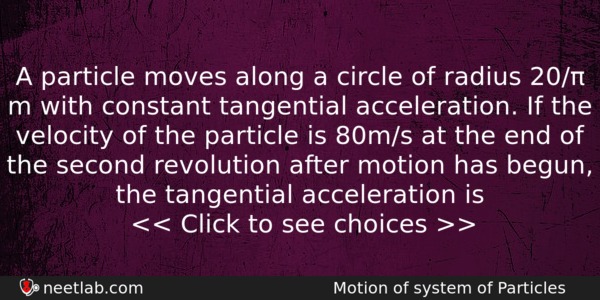| ⇦ | 
| ⇨ |
A particle moves along a circle of radius 20/π m with constant tangential acceleration. If the velocity of the particle is 80m/s at the end of the second revolution after motion has begun, the tangential acceleration is
Options
(a) 640 π m/s²
(b) 160 π m/s²
(c) 400 π m/s²
(d) 40 m/s²
Correct Answer:
40 m/s²
Explanation:
No explanation available. Be the first to write the explanation for this question by commenting below.
Related Questions: - A vibrating string of certain length l under a tension T resonates with a mode
- In a uniform circular motion, work done in one complete rotation is
- The work function for metals A,B abd C are respectively 1.92 eV,2.0 eV and 5 eV.
- Infinite number of masses, each 1 kg, are placed along the x-axis
- Time period of the rotation of the earth about its own axis is 24 hour
Topics: Motion of system of Particles and Rigid Body
(73)
Subject: Physics
(2479)
Important MCQs Based on Medical Entrance Examinations To Improve Your NEET Score
- A vibrating string of certain length l under a tension T resonates with a mode
- In a uniform circular motion, work done in one complete rotation is
- The work function for metals A,B abd C are respectively 1.92 eV,2.0 eV and 5 eV.
- Infinite number of masses, each 1 kg, are placed along the x-axis
- Time period of the rotation of the earth about its own axis is 24 hour
Topics: Motion of system of Particles and Rigid Body (73)
Subject: Physics (2479)
Important MCQs Based on Medical Entrance Examinations To Improve Your NEET Score
18000+ students are using NEETLab to improve their score. What about you?
Solve Previous Year MCQs, Mock Tests, Topicwise Practice Tests, Identify Weak Topics, Formula Flash cards and much more is available in NEETLab Android App to improve your NEET score.
Share this page with your friends

Leave a Reply